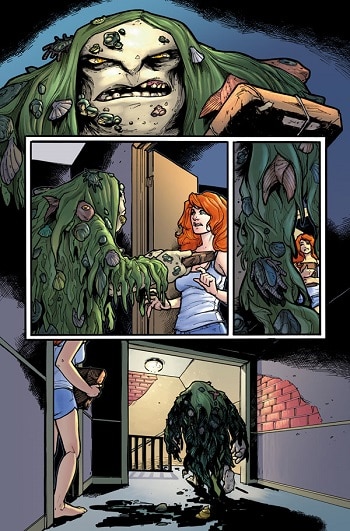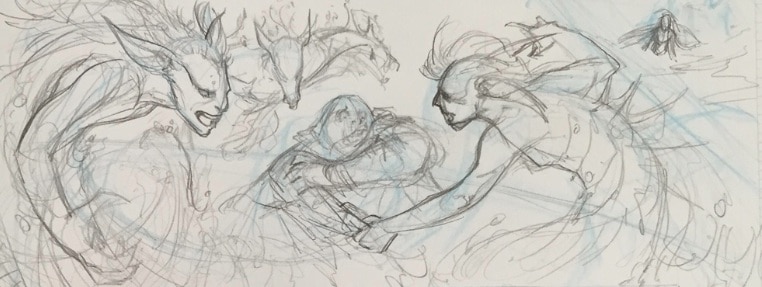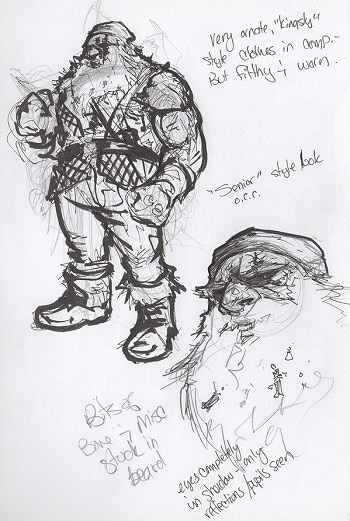RED THORN, the new ongoing series I'm writing for Vertigo, takes place in a world in which the pantheon of Celtic Gods was snuffed out sixteen hundred years ago. Almost all of the deities we mention, meet or slaughter in the story are listed in some dusty tome or ancient report. In fact, we wouldn't even know their names if it weren't for these valiant attempts at recording the beliefs of the Celtic people before the unstoppable flood of time and civilisation washed them into the past.
For example, our main villain, whose identity I won't spoil for you, was a minor war-loving deity worshipped by Roman soldiers and conquered Britons alike. Only a handful of altars dedicated to him survive to this day, a few scratchings in stone and iron. Which was more than enough for me to build a villain upon.
But RED THORN isn't just about the deities.
 Scottish mythology is rich with creatures and entities whose identities are tied to the Earth itself. Nature features heavily in many of their tales, and academics tell us that's because the purpose of these parables was to help ordinary men and women understand the world around them. Of course, being a writer I prefer to believe in more interesting and fantastical possibilities, especially since these narratives are home to so many incredible ideas, many of which I've stolen wholesale for RED THORN.
Scottish mythology is rich with creatures and entities whose identities are tied to the Earth itself. Nature features heavily in many of their tales, and academics tell us that's because the purpose of these parables was to help ordinary men and women understand the world around them. Of course, being a writer I prefer to believe in more interesting and fantastical possibilities, especially since these narratives are home to so many incredible ideas, many of which I've stolen wholesale for RED THORN.
In Scotland, our water is very dramatic. You probably have to travel hundreds of miles if you want to engage in risky, exhilarating pursuits like white water rafting, kayaking or riverboarding. For we Scots it's all in our back garden. I think this is probably the reason that so many of our monsters, gods and beasties are said to have dwelt in oceans, rivers and lochs.
In our very first issue we'll meet a Shellycoat—a despicable creature whose miserable life in the dank, dark rivers of Scotland has left its flesh as rough as oak. He wraps his hideous nude form in a coat made of crustacean shells, hence the name, which clacks when he walks, announcing his presence with a horrible percussive cacophony. In our story he's also murderous and drops chunks of stinking, rotten fish flesh as he walks. This is Vertigo after all.

Kelpies on the other hand are majestic and powerful water spirits who can choose to adopt either human form or that of a horse. In cautionary Scottish folk tales, kelpies would often trick innocent dupes into riding on their back, and then gallop beneath the surface of a nearby body of water. Here experts disagree on whether the victim would be instantly drowned, or devoured, with his or her remains being spat out onto a muddy bank. In some stories, kelpies would retain elements of their equine nature while in human form—for example, cloven hooves—an idea which persisted for centuries and is even mentioned in court transcripts from witch trials in the 15th Century. A couple of years ago, two 100-foot tall sculptures of kelpie's heads were unveiled in Falkirk, an indication of just how deep these myths still run in modern Scottish life.
 Most important of all to RED THORN, though, is the fearsome race of creatures known as the Red Caps.People have told stories about these guys for centuries, especially around the borders where they are said to have operated, flitting between the various ruined castles they called home. Legend has it that even to this day a few of them prowl the countryside looking for 'trespassers' on their lands. These unfortunate travellers don't last long after being discovered, and their fresh, crimson blood is used to soak and dye the peaked hats that give the Red Caps their name. Without this gruesome ritual the creatures would die out, not that this makes it any more palatable.
Most important of all to RED THORN, though, is the fearsome race of creatures known as the Red Caps.People have told stories about these guys for centuries, especially around the borders where they are said to have operated, flitting between the various ruined castles they called home. Legend has it that even to this day a few of them prowl the countryside looking for 'trespassers' on their lands. These unfortunate travellers don't last long after being discovered, and their fresh, crimson blood is used to soak and dye the peaked hats that give the Red Caps their name. Without this gruesome ritual the creatures would die out, not that this makes it any more palatable.
Huge and ugly, armed with rusty pikes and iron boots and gleefully accepting of their truly horrible way of life, as soon as I discovered the Red Caps, I knew they would make a fine army.
Luckily Thorn agreed with me.
RED THORN #1 by David Baillie, Meghan Hetrick and Steve Oliff is now available in print and as a digital download.




















